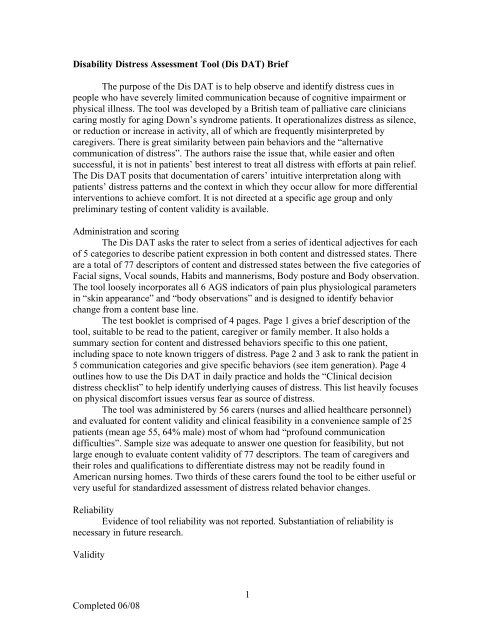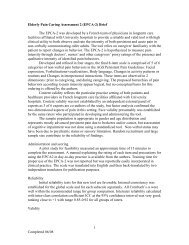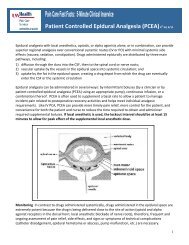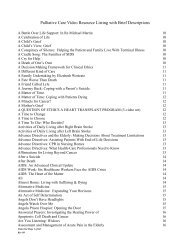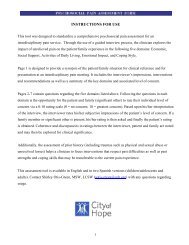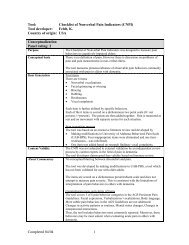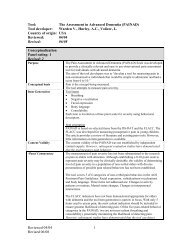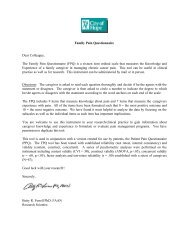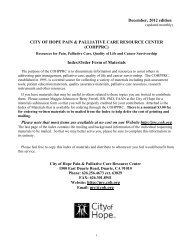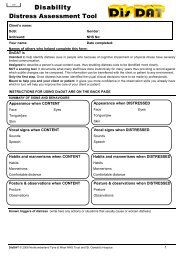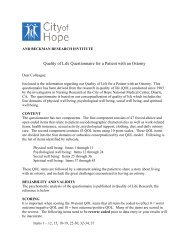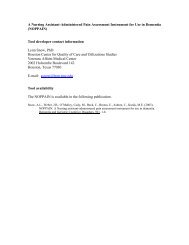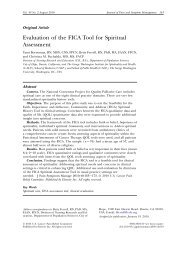1 Completed 06/08 Disability Distress Assessment Tool (Dis DAT ...
1 Completed 06/08 Disability Distress Assessment Tool (Dis DAT ...
1 Completed 06/08 Disability Distress Assessment Tool (Dis DAT ...
You also want an ePaper? Increase the reach of your titles
YUMPU automatically turns print PDFs into web optimized ePapers that Google loves.
<strong><strong>Dis</strong>ability</strong> <strong><strong>Dis</strong>tress</strong> <strong>Assessment</strong> <strong>Tool</strong> (<strong>Dis</strong> <strong>DAT</strong>) BriefThe purpose of the <strong>Dis</strong> <strong>DAT</strong> is to help observe and identify distress cues inpeople who have severely limited communication because of cognitive impairment orphysical illness. The tool was developed by a British team of palliative care clinicianscaring mostly for aging Down’s syndrome patients. It operationalizes distress as silence,or reduction or increase in activity, all of which are frequently misinterpreted bycaregivers. There is great similarity between pain behaviors and the “alternativecommunication of distress”. The authors raise the issue that, while easier and oftensuccessful, it is not in patients’ best interest to treat all distress with efforts at pain relief.The <strong>Dis</strong> <strong>DAT</strong> posits that documentation of carers’ intuitive interpretation along withpatients’ distress patterns and the context in which they occur allow for more differentialinterventions to achieve comfort. It is not directed at a specific age group and onlypreliminary testing of content validity is available.Administration and scoringThe <strong>Dis</strong> <strong>DAT</strong> asks the rater to select from a series of identical adjectives for eachof 5 categories to describe patient expression in both content and distressed states. Thereare a total of 77 descriptors of content and distressed states between the five categories ofFacial signs, Vocal sounds, Habits and mannerisms, Body posture and Body observation.The tool loosely incorporates all 6 AGS indicators of pain plus physiological parametersin “skin appearance” and “body observations” and is designed to identify behaviorchange from a content base line.The test booklet is comprised of 4 pages. Page 1 gives a brief description of thetool, suitable to be read to the patient, caregiver or family member. It also holds asummary section for content and distressed behaviors specific to this one patient,including space to note known triggers of distress. Page 2 and 3 ask to rank the patient in5 communication categories and give specific behaviors (see item generation). Page 4outlines how to use the <strong>Dis</strong> <strong>DAT</strong> in daily practice and holds the “Clinical decisiondistress checklist” to help identify underlying causes of distress. This list heavily focuseson physical discomfort issues versus fear as source of distress.The tool was administered by 56 carers (nurses and allied healthcare personnel)and evaluated for content validity and clinical feasibility in a convenience sample of 25patients (mean age 55, 64% male) most of whom had “profound communicationdifficulties”. Sample size was adequate to answer one question for feasibility, but notlarge enough to evaluate content validity of 77 descriptors. The team of caregivers andtheir roles and qualifications to differentiate distress may not be readily found inAmerican nursing homes. Two thirds of these carers found the tool to be either useful orvery useful for standardized assessment of distress related behavior changes.ReliabilityEvidence of tool reliability was not reported. Substantiation of reliability isnecessary in future research.Validity<strong>Completed</strong> <strong>06</strong>/<strong>08</strong>1
The eight patients evaluated in the preliminary phase for content validitydisplayed 61 behavior changes (median 24) which constitutes 79% of all behaviorchanges possible on the <strong>Dis</strong> <strong>DAT</strong>. Qualitative analysis of distress behavior in 10 casestudies in the assessment phase added the constructs of escalating distress behaviors andsets of signature cues of distress for individual patients, giving initial support for thevalidity of the tool.SummaryThe <strong>Dis</strong> <strong>DAT</strong> is a new tool for clinicians to assess discomfort in persons unable tocommunicate. Content validity for older persons with pain specific conditions warrantsfurther study. The tool would benefit from changes to improve clinical utility. Reliabilityhas not yet been shown for the <strong>Dis</strong> <strong>DAT</strong> and preliminary studies need to be conducted forall psychometrics.<strong>Dis</strong><strong>DAT</strong> is now being evaluated in older adults with Alzheimer's dementia and inchildren with complex needs (Dr. Claud Regnard, personal communication, July 20<strong>08</strong>).Source of evidenceRegnard C., Matthews D., Gibson L., Clarke C. & Watson B. (2003). Difficulties inidentifying distress and its causes in people with severe communication problems.International Journal of Palliative Nursing 9, 173–6.Regnard, C., Reynolds, J., Watson, B., Matthews, D., Gibson, L., & Clarke, C. (2007).Understanding distress in people with severe communication difficulties: Developingand assessing the disability distress assessment tool (<strong>Dis</strong><strong>DAT</strong>). Journal of Intellectual<strong><strong>Dis</strong>ability</strong> Research, 51, 277-292.Contact information:Claud Regnard, FRCPSt. Oswald's HospiceNewcastle upon TyneNE3 5JBe-mail: claudregnard@stoswaldsuk.orgThe tool is free to use and available without restriction on www.disdat.co.uk and theauthors request feedback from users in either clinical or research settings.Review completed by:K. Herr, H. Bursch and B. Black, The University of Iowa (20<strong>08</strong>).Contact: keela-herr@uiowa.edu<strong>Completed</strong> <strong>06</strong>/<strong>08</strong>2


